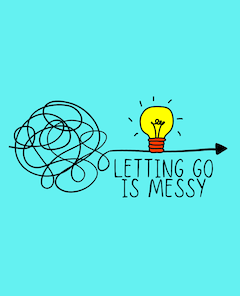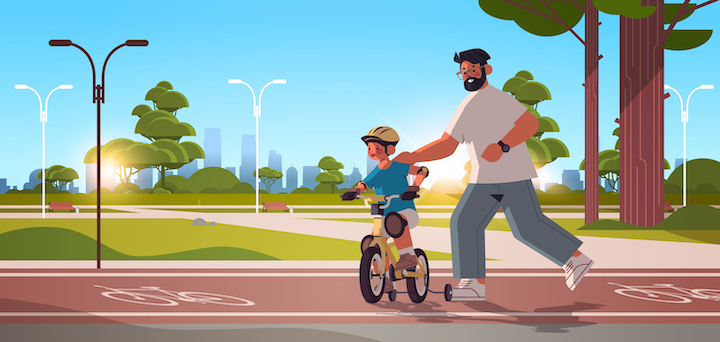The Messy Business of Gradual Release (GRR)
A MiddleWeb Blog
We want students to take more ownership of learning, but how do we help them make that shift, day to day, in real classrooms? In a new year-long blog, Letting Go Is Messy, literacy coaches Sunday Cummins and Julie Webb will explore just that question. They begin with a bike ride.
By Sunday Cummins and Julie Webb

You’ll be fully present as the child makes his first attempt at riding, perhaps running along as takeoff begins, holding on for a bit. Some children may fly. Some may fall and need your help again. Hopefully, with just the right amount of support, each time the child tries to ride, the riding will get easier.
So what does our visualization have to do with the topic of this new blog?
Gradually releasing responsibility is key
In the bike riding endeavor, from start to finish, you gradually release responsibility to the child for riding on their own. This is a critical approach we also use in the classroom. Gradually releasing responsibility (GRR) is a framework for instruction that moves students along a continuum toward independence and traditionally includes the following:
- the teacher modeling how to strategically process or make sense of a text (e.g., “I do”),
- guided practice with the teacher providing feedback and other scaffolds to support students as they “try out” the strategic processing the teacher modeled (e.g., “we do”)
- independent practice where the student works to problem-solve with others (e.g., “you do together) or on their own (e.g., “you do”).
All of these elements are present in our visualization. There’s the element of “I do” – the child has seen you (or others) prepare for and then ride a bike. There’s the element of “we do” where you act as a guide, offering scaffolds (like advice on how to balance, holding on as they start, or constructive feedback when they falter).
Finally there’s the “you do” where the child does the work of trying to ride the bike on their own. This last element is critical to include, right? You don’t want the child to be relying on you to run along beside them every time they ride a bike!
Each of these same stages – including the “you do” – plays a key role in how we help students learn to strategically process or compose complex texts.
GRR is handy in lots of contexts
The child you taught how to ride a bike continues to grow and evolve as a human being. As a result her needs change. What happens when she decides to ride her bike through an obstacle course or over terrain that differs from a sidewalk? What happens when he brings home a unicycle or rollerblades? What happens when he wants to earn a driver’s permit?
Some of what you taught the child will transfer over time. She will know she needs to prepare, to be thoughtful, to try and try again with clear intentions for improvement. However she may still need you, or more knowledgeable others like her peers, to provide scaffolds. In other words, the “I do-we do-you do” can be used in lots of different contexts. “We” will not always be “teacher and student.”
GRR can feel like messy teaching
Effective teaching is a complex process with lots of moving parts. Some we can plan for in advance, but many we have to notice and act on in the moment of the lesson. This is where the bike riding analogy becomes less helpful in thinking about teaching.
When teaching a child how to ride a bike, the steps for teaching and supporting are usually fairly simple. When teaching higher-level thinking, how and when to implement the gradual release of responsibility is not always as comprehensible.
Sometimes really understanding a student’s strengths and needs related to a particular skill may feel difficult. Sometimes we don’t know which scaffold to offer or we offer too many. Sometimes we offer the “I do” and “we do” and students still do not take off on their own. And sometimes we don’t provide enough “you do” opportunities and students do not have the time they need to master a particular way of thinking.
In contemporary practice, educators have become more nuanced in our thinking about the gradual release of responsibility. GRR may happen during one lesson with a group or over the course of several lessons, but it may also happen on the spur of a moment during a reading conference with an individual student who has revealed a need for strategy instruction.
Educators have also realized the value of student peers working together collaboratively (e.g., “you do together”). While many of us have added this component to our practice, we have not always met our intended outcome. We cannot simply say, “Turn and talk” and the students magically construct meaning together. Here is where we have to put the GRR framework to work, noticing moments when we need to support student teamwork, modeling or offering helpful scaffolds, letting go at certain points, and stepping back in later if we see the need.
That’s what this blog is about. The ins and outs of gradually releasing responsibility. The roles teachers play at each point in this framework. The difficulties of making critical decisions before, during, and after teaching. The critical nature of making decisions that nurture each student’s sense of agency (“I can do this”) and identity (“I am a problem solver”). We plan to offer small lessons we ourselves have learned (and continue to learn) in our work with students and teachers, and hope you will join us in this exploration.
Next time: Our suggested GRR framework. The goal is to give students more responsibility, not to give ourselves less.
References
• Fisher, D., & Frey, N. (2008). Better learning through structured teaching. Alexandria, VA: ASCD.
• Pearson, P. D., & Gallagher, M. C. (1983). The instruction of reading comprehension. Contemporary Educational Psychology, 8, 317-344.
• Pearson, P.D., McVee, M. B., & Shanahan, L. E. (2019). In the beginning: The historical and conceptual genesis of the gradual release of responsibility.





































